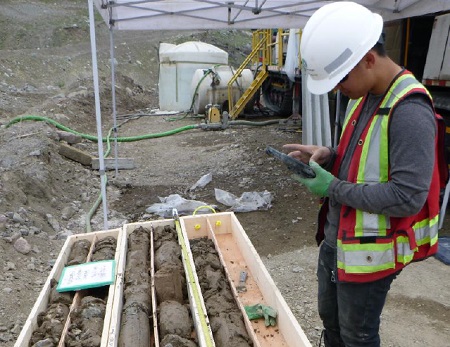Digital Field Data Collection – KCB’s Experience
February 6, 2019 |
Field data collection using pen and paper can be a time-consuming and cumbersome process. However, with new technology such as rugged hand-held tablets and cloud storage, the process is quickly becoming entirely digital. KCB’s experience with digital field data collection shows that it reduces post-processing time, diminishes input errors, maintains consistency, and automates the creation of a single, project-specific database using multiple hand-held devices.
Using all-weather tablets, our field teams can record core logging data directly into pLog™ software with standardized templates. Gone are the days of handwritten drilling logs, re-entry of the same data into a spreadsheet by a different person back in the office and assigning someone else to compile the data so it can be used to make decisions a few days later. Now, field staff can compile the data as it is generated and work with complete data far earlier in the site investigation and design process. This means more time is spent interpreting and understanding the data for the benefit of our clients and professional practice.
KCB’s Prabeen Joshi, Ph.D., recently presented a paper, co-authored by KCB’s Emma Hill, P.Eng., at the ASDSO 2018 Dam Safety Conference in Seattle, Washington. Their paper talks about developing a digital field data collection method, prototyping it in a drilling project, and successfully applying it to four recent projects.
Most geotechnical site investigations are based on information obtained from multiple drilling programs. The typical “pen and paper” approach is shown in Figure 1.

The authors identified some shortcomings and potential risks of the paper-based process, including:
- possible loss of data;
- inconsistencies in data collection;
- higher probability of errors (especially with less experienced loggers); and
- the inability to adjust the drilling program based on unanticipated ground conditions.
In developing a digital field data collection method, KCB set out to:
- make field data collection and processing entirely paperless;
- select a reliable mobile device for logging in all types of field conditions;
- create a standard nomenclature for collecting data; and
- distribute the data in real time to facilitate adjustments to the site investigation program as necessary.
Following a review of several rugged hand-held devices, KCB trialed the Panasonic FZ-A2 and the Xplore XSLATE D10 hand-held devices with the customized data collection software pLog™ on a small site investigation program. KCB engineers log data directly into the mobile device, which is connected to a geotechnical database via a cloud server, to create a preliminary drill hole log (Figure 2).

As part of this trial, KCB also compiled existing geotechnical data from previous drilling programs into the project’s geotechnical database to build on our knowledge of the site foundation.
Following this successful pilot project, KCB invested in rugged tablets and software and is successfully using them on a variety of projects across North America. KCB’s digital field data collection method is illustrated in Figure 3.

Our field engineers found the digital data collection method intuitive and user-friendly, resulting in an efficiently-compiled project geotechnical database, with improved data quality.
The adoption of this digital practice has improved geological, geotechnical and hydrogeological site characterization through real-time adjustments to field programs and reduced time between data collection and data availability to the project team.
KCB is currently expanding its digital data collection method to other field-based activities, including data collection associated with dam safety inspections and reviews.
For more information about KCB’s digital field data collection approach, refer to the paper by Hill and Joshi.
Reference:Hill, E. and P. Joshi. 2018. “Digitizing Field Data Collection and Facilitating Inspections – Our Experience,” in Proceedings of the ASDSO 2018 Dam Safety Conference, Seattle, WA, September 9 – 13, 2018. Lexington, KY: ASDSO (Association of State Dam Safety Officials).
Disclaimer
This Klohn Crippen Berger Ltd. (KCB) blog post is for general information only and does not constitute professional engineering, geoscience or environmental advice. No user should act on the basis of any KCB blog post without obtaining professional advice specific to their situation or project.
